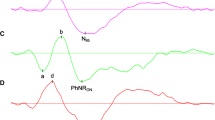Abstract
The pattern electroretinogram was recorded in patients with initial stages of visual field defects due to open-angle glaucoma and in age-matched normal subjects. Both normal subjects and glaucoma patients had a visual acuity above 0.8. Counterphasing checkerboard patterns were used as visual stimuli with a range of check sizes from 0.8° to 15° at 7.8 reversals/s. Whereas the amplitude in glaucoma patients was nearly normal for large check sizes, it was significantly reduced for small check sizes (p = 0.003). Possibly two separate mechanisms that generate the pattern electroretinogram for small and large checks are differentially affected; they may be related to the magnocellular and parvocellular systems. The difference between normals and glaucoma patients was even more significant when the ratios of the amplitudes at small and large check sizes were compared (p < 0.0002). When this ratio is used, the amplitude variability can be partly overcome and the pattern electroretinogram can be a sensitive indicator of ganglion cell function.
Similar content being viewed by others
References
Drance SM, Airaksinen PJ. Signs of early damage in open-angle glaucoma. In: Weinstein GW, ed. Open-angle glaucoma. Contemporary issues in ophthalmology series, volume 3, Edinburgh: Churchill Livingstone, 1986; 17–29.
Wanger P, Persson HE. Pattern-reversal electroretinograms in unilateral glaucoma. Invest Ophthalmol Vis Sci 1983; 24: 749–53.
Papst N, Bopp M, Schnaudigel OE. Helligkeits- und Muster-ERG bei fortgeschrittenem Glaukom. Klin Monatsbl Augenheilkd 1984; 184: 199–201.
Ringens PJ, Vijfvinkel-Bruinenga S, van Lith GHM. The pattern elicited electroretinogram 1. A tool in the early detection of glaucoma? Ophthalmologica, 1986; 192: 171–5.
Aulhorn E, Karmeyer H. Frequency distribution in early glaucomatous visual field defects. Doc Ophthal Proc Series 1976; 14: 75–83.
Trick GL, Wintermeyer DH. Spatial and temporal frequency tuning of pattern-reversal retinal potentials. Invest Ophthalmol Visual Sci 1982; 23: 774–9.
Röver J, Bach M. The pattern ERG and VEP in malingering patients. Doc Ophthalmol 1987; 66: 245–51.
Holder GE, Huber MJE. The effect of miosis on pattern and flash electroretinogram and pattern visual evoked potential. Doc Ophthalmol Proc Series 1984; 40: 109–16.
Arden GB, Carter RM, Hogg CR, Siegel LM, Margolis S. A gold foil electrode: extending the horizons for clinical electroretinography. Invest Ophthalmol Vis Sci 1979; 18: 421–6.
Spekreijse H, Estevez O, van der Tweel LH. Luminance responses to pattern reversal. Doc Ophthalmol Proc Series 1973; 10: 205–11.
Trick GL. Retinal potentials in patients with primary open-angle glaucoma: physiological evidence for temporal frequency tuning deficits. Invest Ophthalmol Vis Sci 1985; 26: 1750–8.
Drasdo N, Thompson DA, Thompson CM, Edwards L. Complementary components and local variations of the pattern electroretinogram. Invest Ophthalmol Vis Sci 1987; 28: 158–62.
Perry VH, Oehler R, Cowey A. Retinal ganglion cells that project to the dorsal lateral geniculate nucleus in the macaque monkey. Neuroscience 1984; 12: 1101–23.
Kaplan E, Shapley RM. The primate retina contains two types of ganglion cells, with high and low contrast sensitivity. Proc Nat Acad Sci 1986; USA 83: 2755–7.
Quigley HA, Sanchez RM, Dunkelberger R, L'Hernault NL, Baginski TA. Chronic glaucoma selectively damages large optic nerve fibers. Invest Ophthalmol Vis Sci 1987; 28: 913–20.
Hess RF, Baker CL, Verhoeve JN, Keesey UT, France TD. The pattern-evoked electroretinogram: its variability in normals and its relationship to amblyopia. Invest Oph Vis Sci 1985; 26: 1610–23.
Wanger P, Persson HE. Pattern-reversal electroretinograms in ocular hypertension. Doc Ophthalmol 1985; 61: 27–31.
Author information
Authors and Affiliations
Rights and permissions
About this article
Cite this article
Bach, M., Hiss, P. & Röver, J. Check-size specific changes of pattern electroretinogram in patients with early open-angle glaucoma. Doc Ophthalmol 69, 315–322 (1988). https://doi.org/10.1007/BF00154412
Issue Date:
DOI: https://doi.org/10.1007/BF00154412




